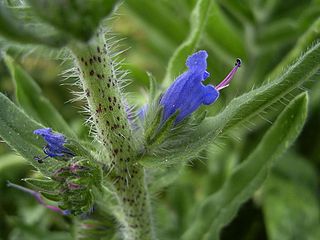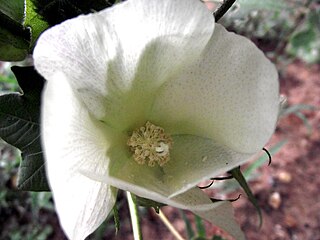Grass refers to the many species of plants in the family Poaceae.

Galium is a large genus of annual and perennial herbaceous plants in the family Rubiaceae, occurring in the temperate zones of both the Northern and Southern Hemispheres. Some species are informally known as bedstraw.

Goosegrass is a common name for several grasses, sedges, and annual herbs. The origin of the name is due either to a plant's use as food for geese or plant parts that look like the foot of a goose.
This article gives an overview of the shingle, strandline and sand-dune communities in the British National Vegetation Classification system.

In biology, an indumentum is a covering of trichomes on a plant or of bristles of an insect.

Eriophyidae is a family of more than 200 genera of mites, which live as plant parasites, commonly causing galls or other damage to the plant tissues and hence known as gall mites. About 3,600 species have been described, but this is probably less than 10% of the actual number existing in this poorly researched family. They are microscopic mites and are yellow to pinkish white to purplish in color. The mites are worm like, and have only two pairs of legs. Their primary method of population spread is by wind. They affect a wide range of plants, and several are major pest species causing substantial economic damage to crops. Some species, however, are used as biological agents to control weeds and invasive plant species.
NVC community SD3 is one of two strandline community in the British National Vegetation Classification system.

Galium boreale or northern bedstraw is a perennial plant species of the Rubiaceae family. It is widespread over the temperate and subarctic regions of Europe, Asia and North America including most of Canada and the northern United States.

Galium spurium, the stickwilly or false cleavers, is a plant species of the Rubiaceae. It is widespread across Europe, Asia, Africa and Canada, and is naturalized in Australia. It is considered a noxious weed in many places.

Stickyweed may refer to several plant species including:

Galium aparine, with common names including cleavers, clivers, catchweed and sticky willy among others, is an annual, herbaceous plant of the family Rubiaceae.

The Jardin botanique textile is a botanical garden specializing in plants used for textiles, baskets, and rope. It is located on Rue Lacordaire, Flavigny-sur-Ozerain, Côte-d'Or, Burgundy, France, and open daily in the warmer months; an admission fee is charged.
British NVC community OV13 is one of the open habitat communities in the British National Vegetation Classification system. It is one of eight arable weed and wasteland communities of fertile loams and clays.
British NVC community OV24 is one of the open habitat communities in the British National Vegetation Classification system. It is one of four tall-herb weed communities.

Cecidophyes rouhollahi is a species of mite in the genus Cecidophyes. It is a plant parasite, or gall, found on cleaver and can be a potential biological control agent for false cleavers, which is a noxious weed in many places.
Poleá or "pulley" is a typical recipe of Andalusian cuisine, particularly the provinces of Seville, Huelva, and Cádiz. It is a variant of porridge typical of those consumed in hard times. The dish is made with water, flour, salt, anise, milk, and sugar. Other ingredients are sometimes added. It is usually served with croutons of fried bread.
Goosetongue is a common name for several plants and may refer to:

Lodge Wood and Sandford Mill is a 2.3-hectare (5.7-acre) biological Site of Special Scientific Interest east of Woodley in Berkshire.











